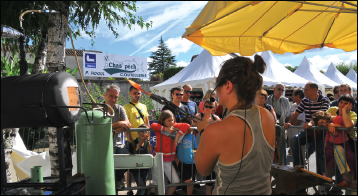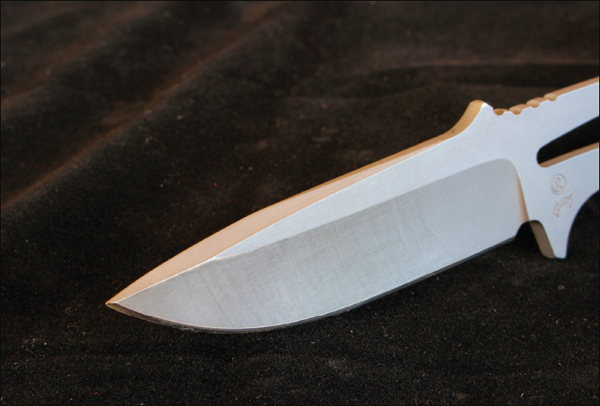
Chapter 13
Materials and Design of the Contemporary Tactical Knife
This is not a technical treatise. Professional knifemakers, metallurgists, and others spend years acquiring their knowledge, both through formal education and hands-on experience. What I will cover here is a once-over light survey of technical information that might be of interest to the tactical knife user.
Many years ago, master bladesmith Wayne Goddard told me that the three most important things in making a good blade—one that will perform and not just look good—were:
1. Selection of steel
2. Heat treat appropriate to the steel being used
3. Geometry of the blade
He further said that a maker must have all three factors working right, not only one or two, to produce a good knife. In many discussions over the years, I have found that virtually all knowledgeable knifemakers and industry experts agree with this statement. My experience has also shown the wisdom of this statement. How these factors come together in a particular blade determine its performance characteristics.
Steel and Heat Treating
Since steel selection is at the top of virtually every discussion on tactical knives, let’s first take a brief look at the heart of every blade: steel. There is a continuing quest for better steel for blades. This has been going on since about 2000 BC, well before the end of the Bronze Age and the widespread adaptation of iron and steel at beginning of the early Iron Age, about 1200 BC. As one might imagine, there have been quite a few developments and improvements in blade steel over the past four thousand years. Much of this improvement is due to competition and the desire to improve tools and weapons.
The rise of the Hittite empire around 1500 BC was made possible by the superiority of their iron weapons. Later, the Israelites waged war on the Philistines to obtain iron-working technology. Today’s commercial competition is considerably less violent but still quite intense. As a result, today we have a wide range of superior steels available to knifemakers that can be ordered from a catalog.
Steel available from steel manufacturers that is in use by knifemakers today includes: 1095, 01, A2, W2, D2, L6, 440B, 440C, ATS34, 5160, VG-10, CPMS30V, and CPMS35V. In addition, many bladesmiths still forge or re-forge their own steel, some from used files, sheer steel, ball bearings, stock billets, and various other sources. There are many different steels in use because mills offer them and individual knifemakers have individual opinions as to which offers them optimal performance. Further, many knifemakers use a variety of steels, choosing each one for its best properties and the customer’s intended use.
Some knife factories also use a wide range of steels, again depending on what optimal performance they seek. Another factor in steel choice can be popularity. Sometimes a customer will read or hear about the properties of a certain steel and request a custom knifemaker use it or choose a knife from a manufacturer’s product line based on what he or she thinks is desirable. In fact, we often see knives marketed as being superior products by virtue of the steel used in their manufacture.
Which is the best steel for a tactical knife? Given that steel performance is dependent on heat treat, blade geometry, and the maker’s skills, as well as the intended use for the knife, there does not appear to be a conclusive answer to that question. I wouldn’t select a knife based on steel type alone, nor should you. As knife users, we don’t buy steel. We buy knives. Every knife is a manufactured product that is the result of a long supply line and the craft and skill of everyone behind it, from the mine that extracted the ore through the steel mill and on to the maker of the finished product. There are many variables in each step along that supply line, each requiring decisions that only someone schooled or trained in the topic can make. Every factor in every step of the process plays a role in the final result—the knife in your hand.

Fred Perrin at the forge © Fred Perrin.
At knife shows, in retail outlets, and around campfires, I have heard and taken part in many discussions about the properties of various knife steels. I have come to the conclusion that beyond certain basics, such discussions among nonprofessionals amount to the same thing as a discussion about how many angels can dance on the head of a pin.
S30V is now highly thought of by many makers with whom I have spoken. This steel was designed and made specifically for knives, which is unusual. Is it the best steel available? Maybe, maybe not. Other makers don’t think much of it at all. Again, it all depends on the skill, craft, and science of the knifemaker. I have some knives made of S30V that take a terrific edge, hold that edge for a long time, don’t show rust even if I deliberately leave them out in the rain for a few days to test for rust resistance, and are tough. I also have knives made of VG-10 and 440C about which similar things can be said. On the other hand, I had a knife of 440C shatter on impact with another blade made of crude steel forged in a nipa hut in the Philippines and S30V blades that chipped and fractured along the edge when cutting pine wood. I have VG-10 blades that I couldn’t put an edge on with hours of work.
So, what’s up here? Shouldn’t there be consistency in steel performance from maker to maker? No, not so much. It’s the package that matters: heat treat, grind, and the maker’s skill all go into making a knife. It’s not just the steel. It’s also who makes the steel and how. If you would like to learn about the technicalities that go into making a knife—steel, heat treat, geometry—I recommend a book by Wayne Goddard, The Wonder of Knifemaking. I know of no better primer on the topic.
Meantime, here’s a quotation from another mastersmith, Daniel Winkler, a man who knows knives and steel and everything that goes into them, who says, “Steels are only as good as how a maker treats them from the beginning. A maker that does his research and tests can get great performance out of mediocre materials, while the best steel can be screwed up with poor handling.” Believe it: it’s the maker, not only the steel.

Elsa Fantino demonstrating heat treat of steel.
Geometry, Designs, Grinds, and Forging
The third critical component of any knife, after steel and heat treat, is the geometry of the blade, or how it is ground. Beyond questions of thick and thin blades are concerns related to the nature of the grind itself and the profile of the blade. In common use today are the following profiles: hollow, flat, convex, saber, and Scandi, which is a variation of saber. Many knives have combination grinds, such as Randalls, but in general whatever grind is predominant is the one by which the knife is described.
Each grind has its advocates, each its detractors. I have seen good performance for virtually all grinds when handled properly by a skilled maker. However, as a general statement, it is my experience that a full convex profile from spine to edge produces the best all-around performance for a tactical and survival knife. The flat grind with a convex edge comes in second. However, the other blade profiles have their place, and I have seen amazingly good performance from hollow ground knives from talented makers, such as Chris Reeve.
The saber grind used on, say, a KA-BAR brings the full thickness of steel the length of the blade, which makes it strong. And the straight saber grind, such as the Scandi, places a good deal of steel behind the edge to support it. In general this makes for a strong blade—one that’s easy to sharpen by using the flat as a bevel guide.

(L-R) Mora knife with a Scandi grind; Spyderco paramilitary with a flat grind; Chris Reeve Professional Soldier with a hollow grind; Wayne Goddard Camp with a convex grind © Justin Ayres.
The hollow grind was originally used to make fullers. Contrary to popular belief, those grooves that run along some blades, especially on swords, are not blood groves; they are fullers, which are meant to lighten the weight of the blade. During the Industrial Revolution, when factory-made steel became readily available, grinding wheels also became available. Round grinding wheels produce a hollow grind and allow for rapid production. This is good for razors and other blades that need to be sharp but have little need for strength. That said, I have seen hollow ground blades from some makers that perform well and are tough.

Flat grind blade on a Spyderco Para-Military with a digital camo handle © Justin Ayres.

Chris Reeve Professional Soldier with a hollow grind blade © Justin Ayres.

Randall Model 1 knife with a choil.

Leverage advantage of knife with no choil.

Mora 2000 model with no choil.
The Choil
I remember when I first saw a choil. One of my training sergeants had a knife that he let me examine. As I handled it, I asked him what the cut out in front of the guard was for. He told me it was for your index finger, so you could choke up on the blade to get more control.
Let me get this straight, I thought. I’m supposed to put my finger, my trigger finger, next to the razor-sharp edge in front of the guard, which is designed to protect my fingers, to get more control over the blade. Well, I about choked up myself. The thought of putting my trigger finger up against the edge, maybe at night, maybe when it’s cold and my fingers are not very sensitive, the thought just . . . well, no. Not gonna happen. Nope. If I want more control, I will extend my finger along the top of the blade the way a butcher or chef might do. I have never seen a butcher knife, any commercial working knife, or any knife made before the twentieth century, for that matter, with a choil, and I have no idea what they’re good for.
I see the choil as a waste of valuable edge. The edge right in front of the guard is where you can bring the most pressure to bear to cut resistant materials, and it is helpful for press cuts, shear cuts, and notching. The edge an inch or so in front of the guard requires about four times as much force for a given cut. I’m sure that some of my readers may be iron-wristed Rambos who would never have such a sissy consideration. But for the rest of us, that spot is very useful. Try the Frost or Fällkniven knives, the RAT RC-4, or any knife without a choil, such as a kitchen knife, and press cut a sapling or shave hardwood and you’ll see what I mean. Some choils, due to their design, can get snagged and hung up while cutting soft materials, which could be a bad thing.
Stock Removal or Forging
The folks who make knives by stock removal often refer to bladesmiths as the heat and beat crowd. There is an ongoing debate on the merits of forging versus stock removal. I’ll leave the final answer to the experts and will only note that of all the knives I have owned, the ones that performed the best came from master bladesmiths of the American Bladesmith Society.